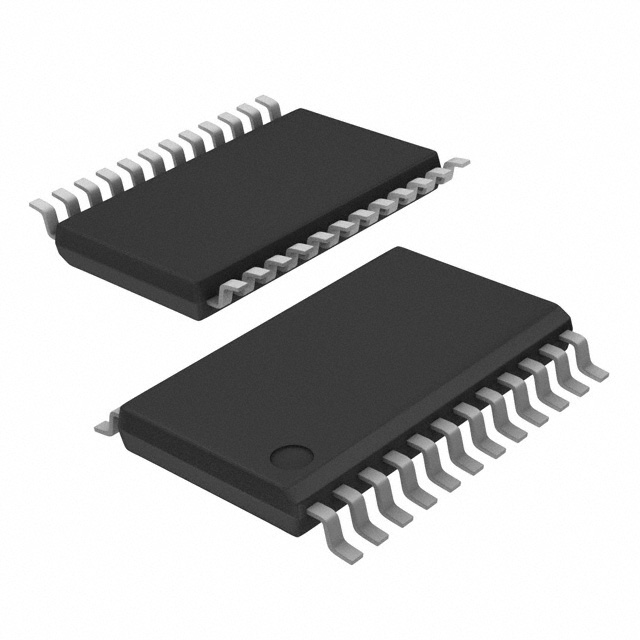Viz Specifikace pro podrobnosti o produktu.

BQ24703PWG4
Product Overview
Category
BQ24703PWG4 belongs to the category of power management integrated circuits (PMICs).
Use
This PMIC is primarily used for battery charging and system power management in portable electronic devices.
Characteristics
- Efficient power conversion and management capabilities
- High level of integration
- Compact package size
- Wide input voltage range
- Multiple protection features
Package
BQ24703PWG4 is available in a small outline, 20-pin TSSOP package.
Essence
The essence of BQ24703PWG4 lies in its ability to efficiently manage power flow between the power source and the battery, ensuring optimal charging and power delivery to the system.
Packaging/Quantity
This PMIC is typically sold in reels, with 250 units per reel.
Specifications
- Input Voltage Range: 4.5V to 28V
- Output Voltage Range: 2.5V to 25.2V
- Charging Current Range: Up to 8A
- Operating Temperature Range: -40°C to 85°C
- Efficiency: Up to 95%
Detailed Pin Configuration
- ACIN: Input voltage from the power source
- TS: Thermistor input for temperature monitoring
- BAT: Battery voltage sense input
- SRN: System reset output
- SDA: I2C data line
- SCL: I2C clock line
- INT: Interrupt output
- VREF: Reference voltage output
- PROCHOT: Processor hot signal input
- ILIM: Charging current limit setting
- STAT: Status output
- CE: Charger enable control input
- SBS: System battery status input
- SDA2: Second I2C data line
- SCL2: Second I2C clock line
- VSS: Ground
- VDD: Power supply voltage
- VCC: Power supply voltage for I2C interface
- TS2: Second thermistor input
- SRP: System reset input
Functional Features
- Dynamic power path management
- Battery charging with thermal regulation
- Input current and voltage regulation
- Charge termination and safety timers
- System power monitoring and control
- I2C communication interface for configuration and status monitoring
Advantages and Disadvantages
Advantages
- Efficient power conversion and management
- Wide input voltage range allows compatibility with various power sources
- Multiple protection features ensure safe charging and operation
- Compact package size enables space-saving designs
Disadvantages
- Limited charging current compared to some high-power devices
- Requires external components for complete system integration
Working Principles
BQ24703PWG4 operates by regulating the flow of power between the input source, battery, and system. It dynamically manages the power path to prioritize charging the battery while simultaneously powering the system. The PMIC monitors various parameters such as input voltage, battery voltage, and temperature to optimize charging efficiency and protect against overcharging or overheating.
Detailed Application Field Plans
BQ24703PWG4 finds applications in a wide range of portable electronic devices, including: - Laptops - Tablets - Smartphones - Portable gaming consoles - Portable medical devices - Portable audio/video players
Detailed and Complete Alternative Models
- BQ24725RGRR
- BQ24727RGRR
- BQ24735RGRR
- BQ24738RGRR
- BQ24745RGRR
- BQ24747RGRR
- BQ24751RGRR
- BQ24753RGRR
- BQ24770RGRR
- BQ24780SRGRR
These alternative models offer similar functionality and can be considered as alternatives to BQ24703PWG4 based on specific application requirements.
In conclusion, BQ24703PWG4 is a power management integrated circuit designed for efficient battery charging and system power management in portable electronic devices. Its compact size, wide input voltage range, and multiple protection features make it suitable for various applications. While it has some limitations in terms of charging current and external component requirements, it offers significant advantages in power conversion efficiency and integration.
Seznam 10 běžných otázek a odpovědí souvisejících s aplikací BQ24703PWG4 v technických řešeních
Sure! Here are 10 common questions and answers related to the application of BQ24703PWG4 in technical solutions:
Question: What is the BQ24703PWG4?
Answer: The BQ24703PWG4 is a battery charger IC designed for use in portable devices such as laptops, tablets, and smartphones.Question: What is the input voltage range supported by the BQ24703PWG4?
Answer: The BQ24703PWG4 supports an input voltage range of 3.9V to 24V.Question: What is the maximum charging current supported by the BQ24703PWG4?
Answer: The BQ24703PWG4 can support a maximum charging current of up to 8A.Question: Can the BQ24703PWG4 charge multiple batteries simultaneously?
Answer: Yes, the BQ24703PWG4 has the capability to charge multiple batteries in series or parallel configurations.Question: Does the BQ24703PWG4 have built-in protection features?
Answer: Yes, the BQ24703PWG4 includes various protection features such as overvoltage protection, overcurrent protection, and thermal shutdown.Question: Can the BQ24703PWG4 be controlled through a microcontroller?
Answer: Yes, the BQ24703PWG4 can be controlled and monitored using a microcontroller via its I2C interface.Question: What is the efficiency of the BQ24703PWG4?
Answer: The BQ24703PWG4 has high efficiency, typically above 90%, which helps to minimize power loss during charging.Question: Is the BQ24703PWG4 compatible with different battery chemistries?
Answer: Yes, the BQ24703PWG4 is compatible with various battery chemistries such as lithium-ion, lithium-polymer, and nickel-based batteries.Question: Can the BQ24703PWG4 support USB Type-C power delivery?
Answer: No, the BQ24703PWG4 does not support USB Type-C power delivery. It is primarily designed for traditional charging applications.Question: Are there any evaluation modules or reference designs available for the BQ24703PWG4?
Answer: Yes, Texas Instruments provides evaluation modules and reference designs that can help in the development and testing of solutions using the BQ24703PWG4.
Please note that these answers are general and may vary depending on the specific implementation and requirements of your technical solution.

